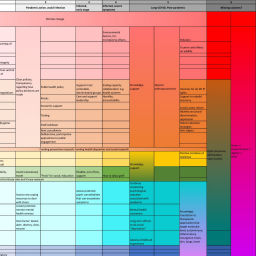COVID-19 through adverse outcome pathways: Building networks to better understand the disease – 3rd CIAO AOP Design Workshop
Main Article Content
Abstract
On April 28-29, 2021, 50 scientists from different fields of expertise met for the 3rd online CIAO workshop. The CIAO project “Modelling the Pathogenesis of COVID-19 using the Adverse Outcome Pathway (AOP) framework” aims at building a holistic assembly of the available scientific knowledge on COVID-19 using the AOP framework. An individual AOP depicts the disease progression from the initial contact with the SARS-CoV-2 virus through biological key events (KE) toward an adverse outcome such as respiratory distress, anosmia or multiorgan failure. Assembling the individual AOPs into a network highlights shared KEs as central biological nodes involved in multiple outcomes observed in COVID-19 patients. During the workshop, the KEs and AOPs established so far by the CIAO members were presented and positioned on a timeline of the disease course. Modulating factors influencing the progression and severity of the disease were also addressed as well as factors beyond purely biological phenomena. CIAO relies on an interdisciplinary crowdsourcing effort, therefore, approaches to expand the CIAO network by widening the crowd and reaching stakeholders were also discussed. To conclude the workshop, it was decided that the AOPs/KEs will be further consolidated, integrating virus variants and long COVID when relevant, while an outreach campaign will be launched to broaden the CIAO scientific crowd.
Article Details

This work is licensed under a Creative Commons Attribution 4.0 International License.
Articles are distributed under the terms of the Creative Commons Attribution 4.0 International license (http://creativecommons.org/licenses/by/4.0/), which permits unrestricted use, distribution and reproduction in any medium, provided the original work is appropriately cited (CC-BY). Copyright on any article in ALTEX is retained by the author(s).
Bezemer, G. F. G. and Garssen, J. (2021). TLR9 and COVID-19: A multidisciplinary theory of a multifaceted therapeutic target. Front Pharmacol 11, 601685. doi:10.3389/fphar.2020.601685
Byrne, A. W., McEvoy, D., Collins, A. B. et al. (2020). Inferred duration of infectious period of SARS-CoV-2: Rapid scoping review and analysis of available evidence for asymptomatic and symptomatic COVID-19 cases. BMJ Open 10, e039856. doi:10.1136/bmjopen-2020-039856
Datta, S. D., Talwar, A. and Lee, J. T. (2020). A proposed framework and timeline of the spectrum of disease due to SARS-CoV-2 infection illness beyond acute infection and public health implications. JAMA 324, 2251-2252. doi:10.1093/cid/ciaa1280
Kim, Y., Park, C., Lim, S. et al. (2021). Advanced adverse outcome pathways potentially bridging pathogenesis of COVID-19. Preprints, 2021010065. doi:10.20944/preprints202101.0065.v1
Kinaret, P. A. S., del Giudice, G. and Dario, G. (2020). Covid-19 acute responses and possible long term consequences: What nanotoxicology can teach us. Nano Today 35, 100945. doi:10.1016/j.nantod.2020.100945
Nymark, P., Sachana, M., Leite, S. B. et al. (2021). Systematic organization of COVID-19 data supported by the adverse outcome pathway framework. Front Public Health 9, 938605. doi:10.3389/fpubh.2021.638605
Polak, S. B., Van Gool, I. C., Cohen, D. et al. (2020). A systematic review of pathological findings in COVID-19: A pathophysiological timeline and possible mechanisms of disease progression. Mod Pathol 33, 2128-2138. doi:10.1038/s41379-020-0603-3
Rai, B., Shukla, A. and Dwivedi, L. K. (2021). Estimates of serial interval for COVID-19: A systematic review and meta- analysis. Clin Epidemiol Glob Health 9, 157-161. doi:10.1186/s12879-021-05950-x
Villeneuve, D. L., Crump, D., Garcia-Reyero, N. et al. (2014). Adverse outcome pathway (AOP) development I: Strategies and principles. Toxicol Sci 142, 312-320. doi:10.1093/toxsci/kfu199
Villeneuve, D. L., Landesmann, B., Allavena, P. et al. (2019). Representing the process of inflammation as key events in adverse outcome pathways. Toxicol Sci 163, 346-352. doi:10.1093/toxsci/kfy047
Vinken, M. (2013). The adverse outcome pathway concept: A pragmatic tool in toxicology. Toxicology 312, 158-165. doi:10.1016/j.tox.2013.08.011
Wang, F., Qu, M., Zhou, X. et al. (2020). The timeline and risk factors of clinical progression of COVID-19 in Shenzhen, China. J Transl Med 18, 270. doi:10.1186/s12967-020-02423-8
Wittwehr, C., Amorim, M. J., Clerbaux, L.-A. et al. (2021). Understanding COVID-19 through adverse outcome pathways – 2nd CIAO AOP design workshop. ALTEX 38, 351-357. doi:10.14573/altex.2102221


